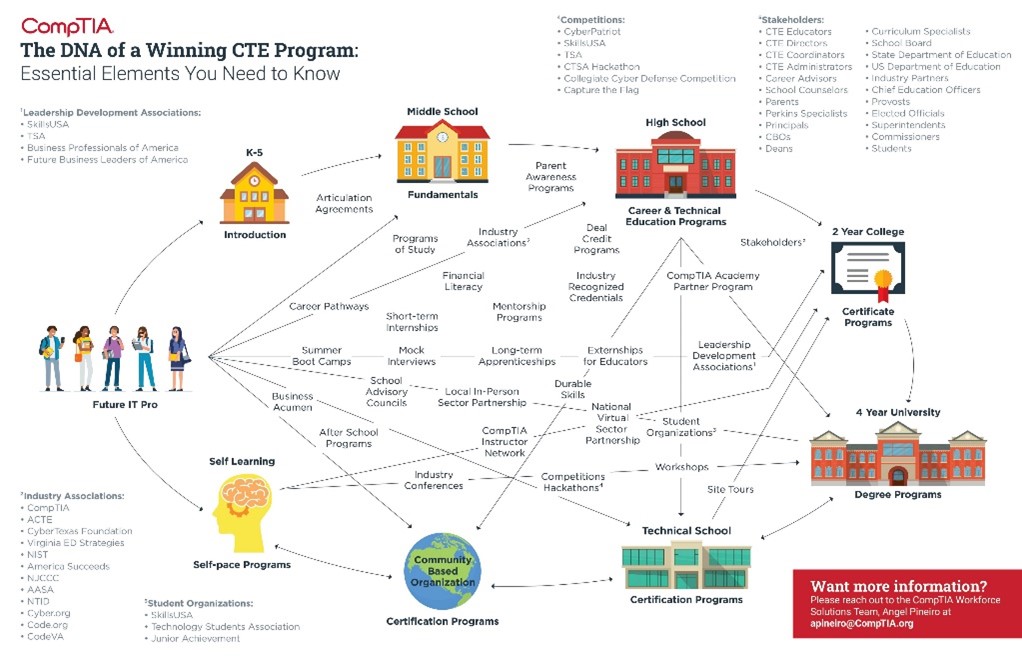 Tech organizations are in a constant race to find skilled and qualified workers who can keep up with ever-evolving demands. Skills and confidence gaps can throw a wrench in the works, making it tough for companies to meet their needs and for individuals to reach their full potential.
Tech organizations are in a constant race to find skilled and qualified workers who can keep up with ever-evolving demands. Skills and confidence gaps can throw a wrench in the works, making it tough for companies to meet their needs and for individuals to reach their full potential.
Having a detailed, well-thought-out plan to address these gaps and set everyone up for success can help an organization build its future workforce needs while also giving today’s students—tomorrow’s employees—the skills and confidence they need to be successful, said Angel Piñeiro, vice president of strategic academic relationships at CompTIA, during a session at CompTIA Partner Summit 2023.
It’s a potential win-win situation, said Piñeiro, who shared an example of how a technology company successfully partnered with the largest school district in the country, a relationship that benefited both parties.
The Problem
In 2013, a large public school district, encompassing 1.1 million students and 1,800 schools, put out a contract to support its entire infrastructure. At the time, Piñeiro was the senior vice president of a national technology firm that won the multi-million-dollar contract. The problem was that they had two months to accomplish the following:
- Hire more than 200professionals, including technicians, engineers, dispatchers and more
- Provide personnel with security clearances
- Integrate the school district’s service desk into the firm’s service desk
“We managed to do it, but I will never, ever be put in that situation again,” Piñeiro said. To avoid running into the same problem in the future, Piñeiro needed a program in place that would create a pipeline of skilled and certified workforce.
The Solution
Faced with the challenge of rapidly recruiting skilled IT professionals, the initial solution was to work with local training providers, talent recruitment companies and college graduates. However, Piñeiro's team realized that these approaches were not only expensive but also lacked the scalability needed to meet the demands of large-scale contracts. They also needed a solution that was efficient and repeatable – it needed to work for everybody.
Then, it clicked.
“There are schools in the cities. There are schools in the suburbs. There are schools in the rural areas. There are schools everywhere. So why not work with the schools?” Piñeiro said.
The DNA of a Successful CTE Program
After determining the key stakeholders they needed to work with, Piñeiro’s team came up with the DNA of a successful CTE program.
Phase 1
The first phase of implementation required making sure that the curriculum or the program of study aligned with what employers needed. After getting connected with the district and placing staff on advisory boards, Piñeiro and his team created a strong work-based learning program to ensure that students who participated are getting real-world experience, receiving mentorship and learning both technical and non-technical/durable skills.
“An internship has to be a formal program where students are actually learning. It's not about free labor, it's not about bringing somebody into your facility and having them do filing for you or do work where they're not learning,” Piñeiro said.
Phase 2
After a few years, Piñeiro’s team added more offerings, such as:
- Summer boot camps
- After-school programs
- Professional development
- Industry conferences
- Leadership development
- Parent awareness programs
- Mock interviews
- CompTIA Instructor Network
Piñeiro’s team also ensured that parents were involved every step of the way, making them aware of the various tech pathways as well as the 30 to 50 high school graduates being hired every year through the CTE program.
“The parents are the ones who talk to their kids when they're in middle school, right? They're the ones who are deciding what high school their kids are going to go to and what programs they should be enrolling in. So, we make sure that we constantly talk to parents through events,” Piñeiro said.
Phase 3
Next, Piñeiro and his team recommended that the school district have articulation agreements with colleges. Articulation agreements ensure that if a student decides not to enter the workforce after graduating high school or feels that it doesn't fit their career goals, the skills, knowledge and certifications they gained while going through the CTE program are still recognized and valued at those colleges.
The CompTIA Connect 4 program was also created during this phase. CompTIA Connect 4 is a framework that connects industry with academia and is comprised of four components: Skills development, industry-recognized credentials, work-based learning and partnerships.
Other offerings that were implemented in phase three include:
- Business acumen programs
- Financial literacy programs
- Career pathways
- Apprenticeships
- Dual credit programs
- Research and innovation labs

Successful Outcomes
The CTE program has proven to be a game-changer, shaping the future of numerous high school graduates and bringing substantial benefits to the organizations involved.
Here are some key outcomes since the inception of the program:
- Duplicated program in other cities
- Cost savings
- Improved speed to hire
- New hires were ready on day one
- Competitive advantage
- Workforce and college-ready graduates
- College admittance advantage
- Educators are better prepared
But the biggest takeaway was Piñeiro seeing just how talented and qualified high schoolers can be. After graduating and going through the CTE program, students kept growing and developing, becoming everything from directors and VPs to engineers and system architects. They're changing their families' futures, earning high salaries and making a real difference.
“I saw how capable these young men and women can be as long as they were provided with the right resources and the right education,” Piñeiro said. Once they have that, they're unstoppable.
Want to be part of the CompTIA National CTE Advisory Council? Apply Here!

